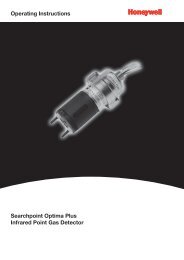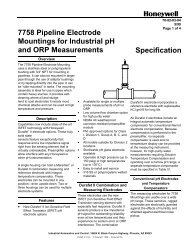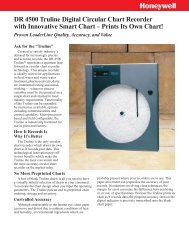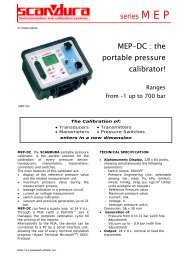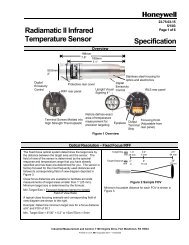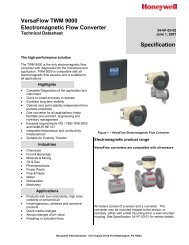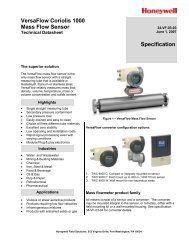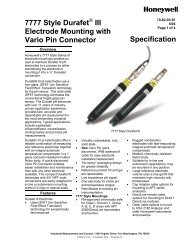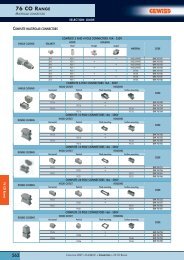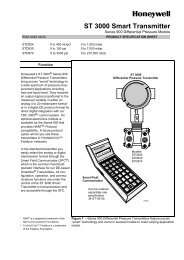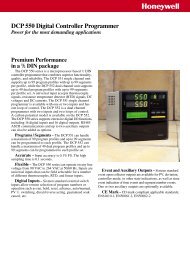PhD6 Multi-Gas Detector Reference Manual - Honeywell Analytics
PhD6 Multi-Gas Detector Reference Manual - Honeywell Analytics
PhD6 Multi-Gas Detector Reference Manual - Honeywell Analytics
Create successful ePaper yourself
Turn your PDF publications into a flip-book with our unique Google optimized e-Paper software.
3. Remove the four screws that are locatedbelow the battery pack insertion from theback face of the PHD6.4. Turn the instrument over to reveal the frontface and gently remove the sensor cover.5. Remove the sensor that is to be replaced.6. Insert the new sensor into the appropriatelocation on the sensor board.7. Reinstall the sensor cover by aligning itproperly over the sensors and securing it withthe four screws that were removed in step 3.8. Reattach the battery pack and re-tighten thetop center screw.9. New sensors must be allowed to stabilizeprior to use according to the followingschedule. The detector must be powered offand a functional battery pack must beinstalled for the sensor to stabilize.Sensor Stabilization PeriodOxygen (O 2 )1 hourLELnonePID5 minutesNDIR-CH 4 or1 minuteNDIR-CO 2All Toxic Sensors15 minutesexcept NONO (nitric oxide) 24 hoursNote: Steps 9 and 10 assume that the sensorstabilization period has passed.10. Perform the Fresh Air/Zero calibration andthe <strong>Gas</strong> calibration as discussed in sections4.2 and 4.3.6.4.2 Care and maintenance of PID sensorsThe two criticalcomponents of a PIDsensor are theelectrode stack andthe lamp. Theelectrode stack can bereplaced in the field. The lamp can be cleaned orreplaced in the field. The frequency ofmaintenance to both items will vary with the typeof usage and the nature of the contaminants towhich the sensor is exposed.As a general rule, baseline shifts tend to becaused by the electrode stack and losses ofsensitivity tend to be caused by the lamp.6.4.2.1 Troubleshooting the PIDWhen to replace the electrode stack:1. Baseline reading climbs following fresh airzeroing of the sensor.2. PID sensor becomes sensitive to humidity.3. Baseline becomes generally unstable.4. Baseline shifts when the instrument is inmotion.When to clean the PID lampLoss of sensitivity in the sensors as shownduring bump-testing (reading will be low).When to replace the PID lampIf the cleaning of the lamp fails to correct a lossof sensitivity, the lamp should be replaced.6.4.2.2 Cleaning and replacing PIDcomponentsTo remove the lamp and stack1. Wash your hands thoroughly.2. On a clean surface, remove the PID sensorfrom the PHD6 as described above (section6.4.1 steps 1-5).3. Place one finger on top of the sensor andinsert the stack removal tool into the two slotsat the top side of the sensor body. Squeezegently until the spring releases and the stackcan be removed from the top of the sensor.The lamp is spring-loaded against the stack,so keeping a finger on top of the stackprevents their ejection from the sensor body.4. Gently remove the stack and pull the lampand spring out of the sensor body. Do nottouch the top of the lamp window with barefingers.5. Set the spring aside.To replace the stack or lamp1. Discard the used lamp, stack or both asneeded and rebuild with replacement part(s).2. Drop the spring into the center of the sensorbody.3. When reinserting the lamp and electrodestack, it is essential to make sure that thelamp is fit snugly into the o-ring slot on theelectrode stack – NOTE PICTURE BELOW.When inserting the lamp into the o-ring slot, itis recommended that a twisting motion isused. When properly assembled, the lampshould then be flush against the stack, andshould be fully supported.4. Snap the stack with lamp attached on to thesensor body so that the sensor is wholeagain and the stack cannot be removedwithout the removal tool.5. The sensor should have a gasket and a filteron it. If necessary, install a sensor filter andgasket on top of the sensor.6. Reinstall the sensor into the PHD6.7. Reassemble the PHD6.28



